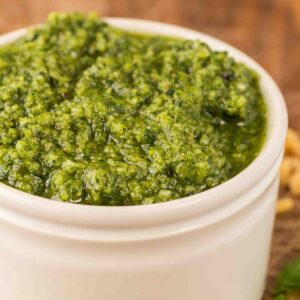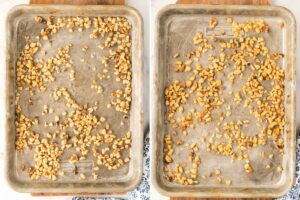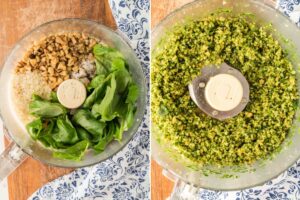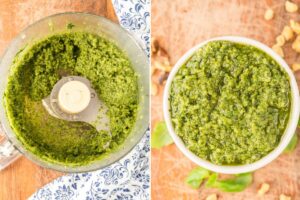How to Make Basil and Walnut Pesto: A Frugal Summer Staple
Basil and Walnut Pesto is the perfect recipe for anyone who wants to enjoy the gourmet taste of pesto without breaking the bank.
All you need to do is grab some fresh basil, walnuts, and parmesan cheese, and you’ll have a delicious pesto that’s perfect for swirling into hot pasta, spreading on sandwiches, or adding to anything else you’d like.
So give it a try and enjoy the gourmet taste of basil pesto without the hefty price tag.
A Newsletter you’ll love
Daily recipes from the farmhouse, Sunday meal plans, seasonal ideas, straight from my kitchen to your inbox.
I promise to keep your email address safe. Unsubscribe at any time
Basil Walnut Pesto

Equipment
- Blender or food processor
Ingredients
- 2 cups fresh basil leaves packed
- ½ cup walnuts toasted
- ½ cup grated Parmesan cheese about 3-4 ounces
- 3 cloves garlic
- ½ cup extra-virgin olive oil
- ½ teaspoon salt
- ¼ teaspoon ground black pepper
Save This Recipe
You'll join my email list which you will love. And if you don't, unsubscribe in one click. ❤️
Instructions
- Toast the Walnuts: Preheat your oven to 350°F (175°C). Spread the walnuts on a baking sheet in a single layer. Toast them in the preheated oven for about 5-7 minutes, or until they become fragrant and lightly browned. Keep an eye on them to avoid burning. Once toasted, remove from the oven and let them cool.

- Prep the Basil: Rinse the fresh basil leaves thoroughly and pat them dry with paper towels. Make sure they are completely dry to avoid a watery pesto. For the freshest taste, remove any tough stems or discolored leaves.
- Blend the Pesto: Place the toasted walnuts, prepared basil, grated Parmesan cheese, garlic cloves, salt, and black pepper in a food processor or blender. Then, pulse the ingredients a few times to coarsely chop them, checking the consistency after each pulse. With the processor running, slowly drizzle in the extra-virgin olive oil until the mixture is well combined and reaches a smooth, creamy texture. Scrape down the sides of the bowl as needed to ensure all ingredients are evenly processed.

- Drizzle in Olive Oil: With the processor running, slowly drizzle in the extra-virgin olive oil until the mixture is well combined and reaches a smooth, creamy texture. Scrape down the sides of the bowl as needed to ensure all ingredients are evenly processed.

- Serve or Store the Pesto: Serve immediately, or carefully store. Transfer the walnut basil pesto to a clean and airtight container. You can store it in the refrigerator for up to a week. For longer storage, you can freeze the pesto in ice cube trays and transfer the frozen cubes to a freezer-safe bag.
Notes
Nutrition
Did You Make This?
I would love it if you would leave a review!More Tips:
If you find the pesto too thick, add more olive oil gradually until it reaches your preferred consistency. This may vary depending on the moisture in the basil leaves.
If you want a milder garlic taste, reduce the amount of garlic or use half a teaspoon of garlic powder.
Taste the pesto after blending and adjust the seasoning accordingly. Sometimes, adding a pinch of salt or a few grinds of pepper can improve its flavor.
Aside from using it with pasta, pesto can be a versatile ingredient in various dishes. You can try it as a marinade for chicken, spread it on grilled sandwiches, or mix it into a vegetable soup for extra flavor.

About the Ingredients
Here are ingredient substitutions you can try:
- Basil: Swap with spinach or arugula for a milder or peppery flavor.
- Walnuts: Use pine nuts, almonds, or pecans instead for a different nutty taste.
- Parmesan Cheese: Try Romano or Asiago cheese for a similar salty taste.
- Extra-Virgin Olive Oil: Avocado or light vegetable oil is a good alternative.
- Garlic: For less strong garlic flavor, use roasted garlic or reduce the amount.

Remember that making these substitutions will change the flavor and texture of the pesto, but experimenting can help you tailor the recipe to your taste preferences!

With these easy steps and practical tips, you can make and store your own Basil Walnut Pesto to add a fresh, homemade touch to your meals.
Enjoy the convenience and flavor of having this versatile condiment at your fingertips!
Love,













